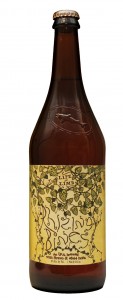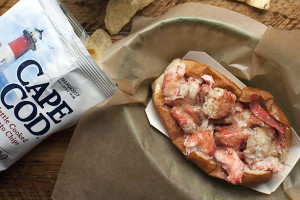Liquid Diet: A Chat with Dogfish Head’s Sam Calagione
Welcome to Liquid Diet, where Christopher Hughes finds the extraordinary stories behind the people and places that quench the thirst of the Boston area.
 Photo courtesy of Dogfish Head
Photo courtesy of Dogfish Head
At times, talking with Dogfish Head founder Sam Calagione is like engaging in conversation with Dos Equis’ bearded pitchman or a less bombastic J. Peterman. The uber-successful, globetrotting Calagione is a pioneer in the brewing world and an icon for home brewers everywhere. The Massachusetts native opened Dogfish Head seventeen years ago in Delaware, and immediately soared into cult status with legions of dedicated fans, many of who are now opening their own breweries that challenge the status quo.
In the meantime, Calagione has become a de facto figurehead for the craft beer industry with his youthful good looks and his daring concoctions, with ingredients that range from peat-smoked barley and saffron to tea leaves and, even, human saliva. This week, Calagione is returning to his home state (he grew up in Greenfield) to take part in Boston’s sold-out Extreme Beer Fest and to unveil his newest beer, Rhizing Bines, a collaboration with Sierra Nevada’s Ken Grossman. We chatted with him recently about the alarming number of new of craft breweries, his favorite adventures abroad, and the beers that have inspired his off-centered quest.

A look at the bottle for Rhizing Bines, debuting at the Extreme Beer Fest this weekend. (Photo courtesy of Dogfish Head.)
There are a staggering number of new craft breweries opening each new year. There are almost 2800 licensed brewers and about 2300 brick and mortar breweries, the most ever in the U.S. Are there enough raw materials to sustain that amount of growth?
SC: That’s a great question. For the first time in our country, there’s a commercial brewery opening every day in America. It’s an amazing statistic! Frankly, you don’t have to be an economist to understand that that rate is not sustainable because there are only a finite number of taps at a bar, and shelves at a liquor store, and cubic feet in a distributors box truck to accommodate different beers and different brands. That said, I’m really excited that so many small craft brewers are growing. I bet we’ll see an equilibrium where economic darwinism will take place. Those that are brewing awesome, distinct, well-differentiated beer regardless of their scale, regardless of their geographic ambition will figure out a way to make it. I also love that these hundreds of new breweries will be out there in the marketplace talking with local consumers about what it means to be a small independent entreprenurial craft brewer, because that’s very different than being the producers of something like Shocktop or Blue Moon or Goose Island; some of these faux craft brands that are marketed to seem like they came from small independent breweries but in fact are owned by some of the biggest global conglomerates in any industry.
Sierra Nevada (Chico, CA), who you collaborated with on Rhizing Bines, recently opened a second brewery in North Carolina and Lagunitas (Petalumas, CA) also expanded into Chicago. Can you explain their motivation and would Dogfish Head ever consider a second location of their own?
Most of our country’s edibles, like produce, are grown in the west and sent to the more populated urban centers on the east coast. So shipping rates going west to east are generally about twice than those going east to west. So for a brewery like Lagunitas or Sierra Nevada on the far west coast, it’s millions of dollars difference each year. And pretty soon those millions add up and you say, “we might as well open a facility on the other coast to mitigate these additional shipping costs.” For Dogfish, we love living at what some people in big cities might say is the middle of nowhere. We’re literally two hours from a major city. But we’re exactly two hours from D.C., Baltimore, and Philly. We’re only 3 hours away from Manhattan. So all these great urban cities are very accessible to us in coastal Delaware, but we get to work at the beach and wear flip-flops to work everyday. The other thing is, living in rural, coastal Delaware our cost of acreage is one-tenth of what it would be around Boston or one-twentieth what it would be around San Francisco or Napa. We see Dogfish’s growth model as just keeping our production in coastal Delaware and adding fun components to our business that compliment our brewery, our restaurant, and our distillery.
A lot of experts are predicting a surge in popularity and focus on session beers and a subsequent waning of higher alcohol, extreme beers. Dogfish has always been known for bigger beers that push the boundaries of traditional beer styles. Do you think consumers are coming to session beers organically and are craft brewers like yourself brewing more session beers due to supply issues with ingredients like hops?
I think it’s ridiculous to think that in order for excitement around session beers to grow that bigger, stronger beers have to diminish in the market place. I think that all good, flavorful, unique, well-differentiated beer deserves to grow, and will grow. There are times we just want to drink beers that are stronger in alcohol, when we’re having a great flavorful meal, maybe in place of wine; and they’re times when we’re hanging out with our friends and watching the Super Bowl that we’d prefer to drink something more sessionable. And while Dogfish might be known for bigger, more exotic beer, we were the first American brewery to make a Berliner Weisse, the Festina Peche, which is less than 5% alcohol; one of our fastest growing brands is our Chicory Stout, which is less than 5% alcohol and is one of the first chicory and coffee beers in America.
You talked about being in competition with the spirits industry and especially the wine world. I think it’s interesting that you tend to blur the line between beer and wine with some of your products like Red and White, which is brewed with Pinot Noir grapes, and Noble Rot, which is brewed with Viognier juice infected with the fungus, botrytis.
That’s a good point and something we’re super proud of. In 1996, I wanted to brew something that would be the perfect partner for steak, because at our brewpub we originally cooked everything over a wood grill. I wanted to reverse engineer a beer that would be almost Bordeaux-like, as an ultimate partner for steak. That led to the Raison D’Etre recipe, which is made with these special green raisins and beet sugars and has a ton of red wine characteristics. That was our first beer and wine hybrid. Then a few years later we did Midas Touch and after that we did Noble Rot and Red and White and now we’re coming out with a new one in early March called Sixty-One, which is 60 Minute IPA plus one ingredient. We spent a year vetting different red grape musts and we found some great Syrah from California, which we dose into this IPA during primary fermentation. It gives it a ton of red wine character that compliments the fruity, citrusy note of the hop. We’re really psyched for it!
Brew Masters, the reality show on the Discovery Channel, followed you on your journeys to exotic locations to track down ancient recipes and regionally-specific ingredients. What are some of your fondest memories from all your years abroad?
Around twelve years ago, I remember being in Turkey doing a show for the BBC. We were at the tomb belonging to King Midas and I remember sitting and arguing with wine makers on which of our beverages had a longer and more esteemed history. At that moment a tear gas bomb went off in the restaurant we were sitting in because of political unrest in Turkey. That ended the argument. I also remember being in a tomb underneath a pyramid in Egypt where I got to see, on the wall, the earliest artistic rendering of my profession: a hieroglyph of a brewer. That was a pretty existential moment.
Out of all the crazy beers that you’ve attempted to brew, have there been ones that haven’t worked and never made it to the market?
Well, we probably won’t be brewing our Chicha beer in volume. That’s the one where we got all of our coworkers to come together and chew all this dry Peruvian corn. The enzymes in human saliva convert the starches to sugar. That was the closest I’ve ever been to a mutiny situation.
You mentioned in Brew Masters that you have some family history in New England.
All my youth and history is there. I grew up in a town called Greenfield off 91. When I was a teenager, my parents bought a farm in Montague, which is about five miles from Amherst. I recently bought that family farm from my parents. My wife and I use it for raising grass-fed beef, which we use at our brewpub. We also use it to harvest the maple syrup that goes into our 75 Minute IPA and our Immort Ale. We also use it to do some sustainable timbering. We’re getting ready to do an expansion at our brewery in Milton [in DE] and one of our floors will be made from the harvested wood from the farm.
Do you have any favorite breweries in the Boston area?
The brewers that immediately come to mind when I think of Massachusetts brewing are Will [Meyers] from Cambridge Brewing, Dann [Paquette] from Pretty Things, Matt [Steinberg] from Blatant Brewery, and Gary [Bogoff] from Berkshire Brewing Company. Those are the four that immediately come to mind. I cut my teeth drinking Harpoon and Sam Adams. They were some of the first craft beers I ever drank. Northampton Brewery was one of the first brewpubs I even went to. So for me, Extreme Beer Fest is like coming home.
Finally, what was the craft beer that set you on this path?
In 1993 I started working at a beer-centric restaurant in Manhattan. In one week I tried both Sierra Nevada Celebration and Chimay red. And while they’re very different beers, I was like, “Holy crap!”
Calagione will be pouring Rhizing Bines at the sold-out Extreme Beer Fest at The Cyclorama in the South End this weekend.


